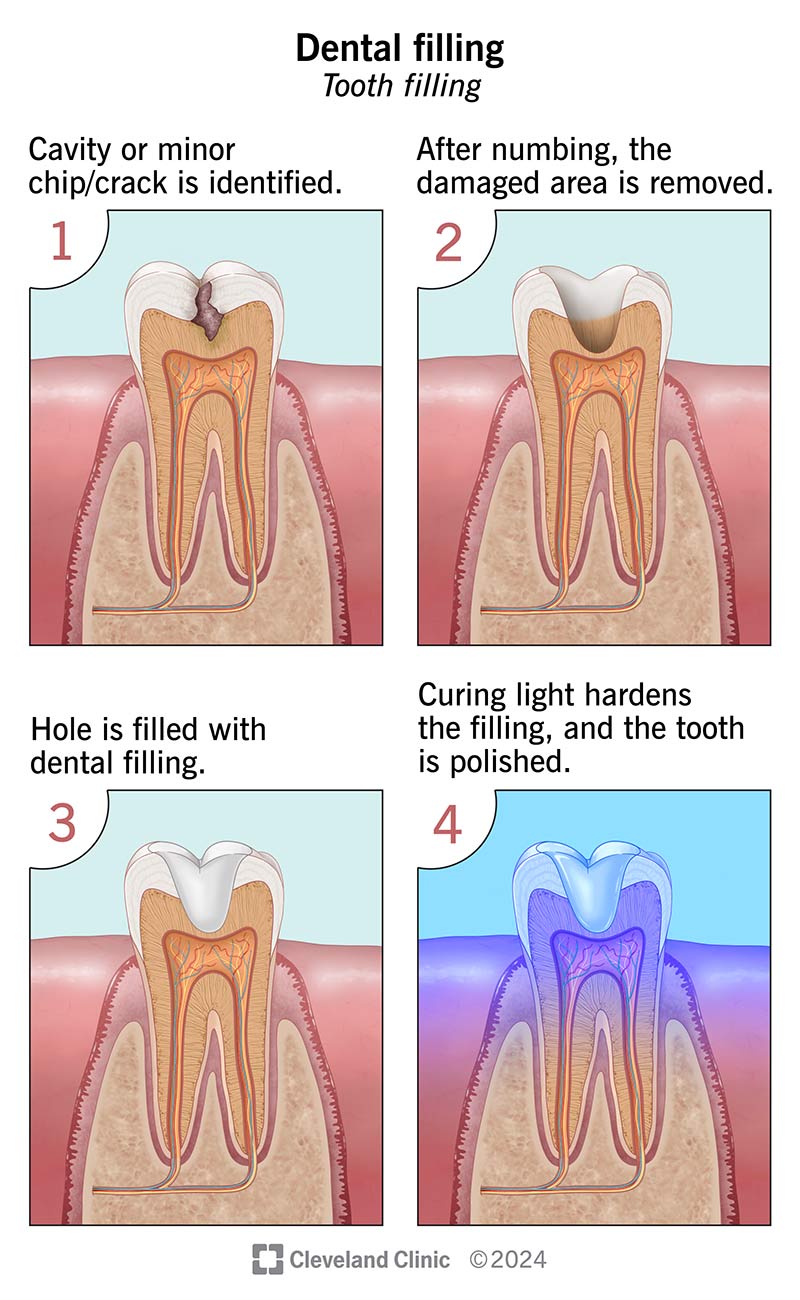Dental fillings help repair tooth cavities. Dentists use them to “fill in” areas of damage or decay. There are several types of fillings, including amalgam and tooth-colored options like composite resin and porcelain. Depending on the material used, some dental fillings can last up to 20 years.
Advertisement
Cleveland Clinic is a non-profit academic medical center. Advertising on our site helps support our mission. We do not endorse non-Cleveland Clinic products or services. Policy

Dental fillings are a type of restorative dentistry treatment. Dentists use them to repair cavities or fix minor chips and cracks in your teeth.
Advertisement
Cleveland Clinic is a non-profit academic medical center. Advertising on our site helps support our mission. We do not endorse non-Cleveland Clinic products or services. Policy
Other names for dental fillings include:
Your dentist can discuss treatment options with you and determine which type of dental filling is better for your situation.
There are many different types of dental fillings. But they all fall into one of two categories: direct or indirect.
Dentists create and place direct fillings in your mouth without the need for a dental laboratory or temporary restoration. A direct filling only requires one office visit.
Common materials for direct fillings are:
A dental technician must make indirect fillings in a lab before your dentist places them in your mouth. Most indirect fillings require two office visits — one to take dental impressions and another to place your restoration. If your dentist uses CAD/CAM (computer-aided design/computer-aided manufacturing) technology, they may be able to create and place your indirect filling in a single appointment.
Advertisement
Inlays and onlays are two common types of indirect fillings. Dentists use them when a tooth has too much damage to support a filling but not enough damage to warrant a dental crown. An inlay or onlay fits into your existing tooth structure like a tiny puzzle piece.
Common materials for indirect fillings include:
Exact steps can vary depending on the material your dentist uses and the type of filling they place. But here’s a general idea of what to expect.
A dentist will:
If you have anxiety about visiting the dentist, ask about sedation options. Sedation dentistry helps keep you calm and comfortable during your procedure.
Dental fillings treat existing tooth decay and reduce the risk of future damage. Depending on the type of filling, they can also:
After a dental filling procedure, it’s normal to experience minor teeth sensitivity and gum soreness in the area. These side effects are temporary and should go away in a week or two.
Complications that may require additional treatment are less common, but may include:
The American Dental Association (ADA), the U.S. Food and Drug Administration (FDA) and numerous public health agencies say that silver (mercury-based) amalgam fillings are safe. But the FDA recently issued updated recommendations about the use of amalgam fillings in certain people. According to their research, some individuals may have a higher risk for harmful health effects of mercury vapors and should avoid getting amalgam fillings whenever possible.
Advertisement
People at greater risk include:
The FDA doesn’t recommend removing dental amalgam in people at higher risk if the amalgam is in good condition. Doing so may increase exposure to mercury vapor and result in more risks than benefits.
Unless you had sedation, you should be able to return to routine activities immediately after your appointment. Over-the-counter pain relievers like acetaminophen (Tylenol®) or ibuprofen (Advil®) can help manage any soreness or sensitivity.
Technically, you can eat or drink whatever you want as soon as your procedure is over. It won’t damage your new filling in any way. But waiting until the numbness wears off can keep you from accidentally biting the inside of your cheeks. If you do eat right away, chew slowly and be mindful.
Advertisement
Getting a filling shouldn’t hurt because your dentist will use local anesthesia to numb the area. If you feel any discomfort during your procedure, let your dentist know so they can give you more numbing medication.
Before a dentist places a filling, they must remove the decayed or damaged portion of your tooth. Leaving diseased tissue behind can cause the cavity to grow larger.
If a cavity grows so large that it reaches the pulp of your tooth, a dental filling won’t fix the issue. In this situation, you would need a root canal.
Let’s face it — no one really loves going to the dentist. But when it comes to treating cavities, the earlier the better. Dental fillings strengthen your existing tooth structure and reduce your risk of further decay. That means less time in the dental chair and less money spent in the long run. To reduce your overall risk of tooth decay, be sure to visit a dentist for regular cleanings and checkups.
Advertisement
Dentistry plays an important role in oral health. Cleveland Clinic’s experts can design a personalized plan that will keep you smiling for the long haul.

Last reviewed on 05/13/2024.
Learn more about the Health Library and our editorial process.